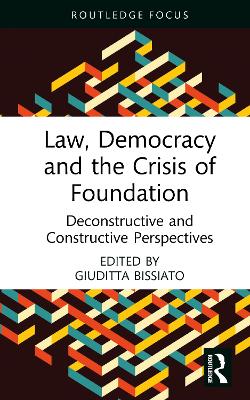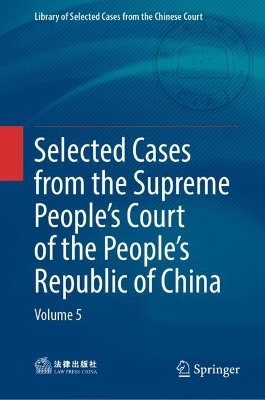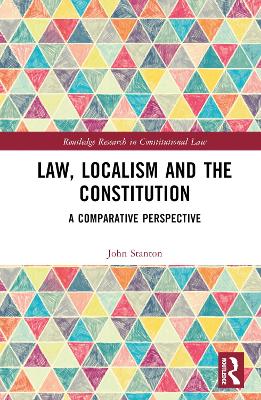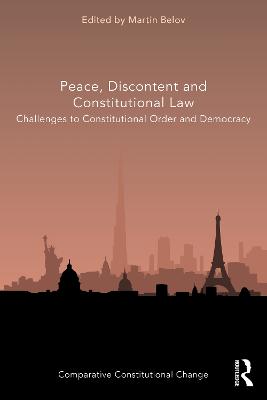Applied Legal Pluralism
 portes grátis
portes grátis
Applied Legal Pluralism
Processes, Driving Forces and Effects
Leclair, Jean; Otis, Ghislain; Theriault, Sophie
Taylor & Francis Ltd
07/2022
270
Dura
Inglês
9781032263960
15 a 20 dias
680
Descrição não disponível.
The management of legal pluralism: processes, parameters for action, and effects
Introduction
1.Definitions and terminological consideration
. Legal
. Pluralism
2.A descriptive and exegetical approach
3.Normative relevance
Chapter 1
Processes of legal pluralism management
Introduction
1.Management through the articulation of systems
1.1. Articulation by reception
1.1.1.Constitutional and legislative reception of non-State law
1.1.1.1. Africa
1.1.1.2. South Pacific
1.1.1.3. Canada
1.1.2. Low-intensity reception of non-State law
1.1.3.Reception of State law by non-State systems
1.1.3.1 The general rule of non-reception
1.1.3.2. Some cases of reception
1.2. Articulation by withdrawal
1.2.1. Withdrawal by non-State systems
1.2.1.1. Roma law in Romania
1.2.1.2. Customary law in Burundi
1.2.1.3 Kanak law in the South Pacific
1.2.1.4. Indigenous law in Canada
1.2.2. Withdrawal by the State
1.2.2.1. Romania
1.2.2.2. Africa
1.2.2.3. South Pacific
1.2.2.4. Canada
1.2.3. Pragmatism, informality and discretion
2.Management through the adaptation of systems
2.1. Adaptation by imitation
2.1.1The imitating State
2.1.2..State law as purveyor of solutions for non-State law
2.2. Adaptation by endogenous modulation of non-State systems
Conclusion
Chapter 2
Parameters of action in a context of legal pluralism
Introduction
1.Factors structuring action in a context of legal pluralism
1.1 The instability and mutability factor: The influence of intersystemic relationships on the actors
1.2The cognitive factor: the actors' perceptions of the legal systems at play
1.3The capacity factor: the spatial dimension of the authority of legal systems
1.3.1The effectiveness of the co-existing legal systems
1.3.The legitimacy of co-existing legal systems
2.The influence of the vitality of legal systems on State and Non-State Actors
2.1. State system agents
2.1.1 The problem of contingency
2.1.2.Objectives shared by all States
2.1.3.The preference of strong States for non-management
2.1.4The preference of weak States for articulation by reception or withdrawal
2.1.5.Actions of State agents
2.2 Agents of non-State legal systems
2.2.1. Objectives shared by all non-State legal systems
2.2.2.Strong non-State legal systems: wavering between official and unofficial articulations
2.2.3.Weak non-State legal systems: a (mandatory?) preference for official articulation
2.2.4.Actions of non-State agents
2.3. Individuals in a pluralist context
Conclusion
Chapter 3
The effects of legal pluralism management
Introduction
1.The effects of non-management
1.1 Effects on systems
1.2. Effects on individuals
1.2.1. The benefits and perils of unmanaged plurality
1.2.2. Legal relativity and individual inter-systemic migrations
1.2.3. Individual action as a definitional feature of legal pluralism?
2. The effects of management processes on managing systems
2.1. Articulation
2.1.1 Articulation by reception
2.1.1.1 Legal hybridization
. Canada
. The South Pacific
. Africa
2.1.1.2. The dualization and personalization of the law
2.1.1.3. A choice of law within the State system
2.1.2. Articulation by withdrawal
2.1.2.1. The suspension of the articulating system
2.1.2.2. The suspension of competition and conflict
2.1.2.3. The personlization of the law
2.2. Adaptation
2.2.1 The reduction of normative conflict
2.2.2. The intensification of competition
3. The effects of management processes on individuals
3.1. Articulation by reception
3.1.1. A more complex set of legal options
3.1.2. The shield and lever effect within State law
3.1.3. The legal capture of identity
3.2. Articulation by withdrawal
3.2.1. The benefits and perils of withdrawal
3.2.2. The legal capture of identity
3.3. Adaptation
3.3.1 Imitation
3.3.2 Endogenous modulation
4. The effects of management processes on the system of reference
4.1. Legal internality and the autonomy of the system of reference
4.2 The competition effect
4.3. The channelling effect
4.4. The defensive adaptation effect
4.5. The incidental re-invigoration effect
4.6. The externalisation effect
Conclusion
Realities and myths of legal pluralism management
1. Free pluralism and managed pluralism
2. The limits of "do-it-yourself" pluralism
3. The State's ordering capacity defused by the autonomy of systems
4. The pluralist management of pluralism
5. Beyond legal pluralism
Bibliography
Introduction
1.Definitions and terminological consideration
. Legal
. Pluralism
2.A descriptive and exegetical approach
3.Normative relevance
Chapter 1
Processes of legal pluralism management
Introduction
1.Management through the articulation of systems
1.1. Articulation by reception
1.1.1.Constitutional and legislative reception of non-State law
1.1.1.1. Africa
1.1.1.2. South Pacific
1.1.1.3. Canada
1.1.2. Low-intensity reception of non-State law
1.1.3.Reception of State law by non-State systems
1.1.3.1 The general rule of non-reception
1.1.3.2. Some cases of reception
1.2. Articulation by withdrawal
1.2.1. Withdrawal by non-State systems
1.2.1.1. Roma law in Romania
1.2.1.2. Customary law in Burundi
1.2.1.3 Kanak law in the South Pacific
1.2.1.4. Indigenous law in Canada
1.2.2. Withdrawal by the State
1.2.2.1. Romania
1.2.2.2. Africa
1.2.2.3. South Pacific
1.2.2.4. Canada
1.2.3. Pragmatism, informality and discretion
2.Management through the adaptation of systems
2.1. Adaptation by imitation
2.1.1The imitating State
2.1.2..State law as purveyor of solutions for non-State law
2.2. Adaptation by endogenous modulation of non-State systems
Conclusion
Chapter 2
Parameters of action in a context of legal pluralism
Introduction
1.Factors structuring action in a context of legal pluralism
1.1 The instability and mutability factor: The influence of intersystemic relationships on the actors
1.2The cognitive factor: the actors' perceptions of the legal systems at play
1.3The capacity factor: the spatial dimension of the authority of legal systems
1.3.1The effectiveness of the co-existing legal systems
1.3.The legitimacy of co-existing legal systems
2.The influence of the vitality of legal systems on State and Non-State Actors
2.1. State system agents
2.1.1 The problem of contingency
2.1.2.Objectives shared by all States
2.1.3.The preference of strong States for non-management
2.1.4The preference of weak States for articulation by reception or withdrawal
2.1.5.Actions of State agents
2.2 Agents of non-State legal systems
2.2.1. Objectives shared by all non-State legal systems
2.2.2.Strong non-State legal systems: wavering between official and unofficial articulations
2.2.3.Weak non-State legal systems: a (mandatory?) preference for official articulation
2.2.4.Actions of non-State agents
2.3. Individuals in a pluralist context
Conclusion
Chapter 3
The effects of legal pluralism management
Introduction
1.The effects of non-management
1.1 Effects on systems
1.2. Effects on individuals
1.2.1. The benefits and perils of unmanaged plurality
1.2.2. Legal relativity and individual inter-systemic migrations
1.2.3. Individual action as a definitional feature of legal pluralism?
2. The effects of management processes on managing systems
2.1. Articulation
2.1.1 Articulation by reception
2.1.1.1 Legal hybridization
. Canada
. The South Pacific
. Africa
2.1.1.2. The dualization and personalization of the law
2.1.1.3. A choice of law within the State system
2.1.2. Articulation by withdrawal
2.1.2.1. The suspension of the articulating system
2.1.2.2. The suspension of competition and conflict
2.1.2.3. The personlization of the law
2.2. Adaptation
2.2.1 The reduction of normative conflict
2.2.2. The intensification of competition
3. The effects of management processes on individuals
3.1. Articulation by reception
3.1.1. A more complex set of legal options
3.1.2. The shield and lever effect within State law
3.1.3. The legal capture of identity
3.2. Articulation by withdrawal
3.2.1. The benefits and perils of withdrawal
3.2.2. The legal capture of identity
3.3. Adaptation
3.3.1 Imitation
3.3.2 Endogenous modulation
4. The effects of management processes on the system of reference
4.1. Legal internality and the autonomy of the system of reference
4.2 The competition effect
4.3. The channelling effect
4.4. The defensive adaptation effect
4.5. The incidental re-invigoration effect
4.6. The externalisation effect
Conclusion
Realities and myths of legal pluralism management
1. Free pluralism and managed pluralism
2. The limits of "do-it-yourself" pluralism
3. The State's ordering capacity defused by the autonomy of systems
4. The pluralist management of pluralism
5. Beyond legal pluralism
Bibliography
Este título pertence ao(s) assunto(s) indicados(s). Para ver outros títulos clique no assunto desejado.
Legal Pluralism;non-State Legal Systems;non-State Law;Solomon Islands;International Monetary Fund;Indigenous Legal Systems;Customary Law;non-State Legal Order;non-State Legal;Indigenous Legal Cultures;Indigenous Law;non-State System;Endogenous Modulation;Customary Legal Systems;non-State Agents;Indigenous Legal;Legal Pluralist Situation;Customary Marriage;Official Customary Law;Customary Adoption;State Justice System;Treaty Rights;State Civil Courts;Kanak People
The management of legal pluralism: processes, parameters for action, and effects
Introduction
1.Definitions and terminological consideration
. Legal
. Pluralism
2.A descriptive and exegetical approach
3.Normative relevance
Chapter 1
Processes of legal pluralism management
Introduction
1.Management through the articulation of systems
1.1. Articulation by reception
1.1.1.Constitutional and legislative reception of non-State law
1.1.1.1. Africa
1.1.1.2. South Pacific
1.1.1.3. Canada
1.1.2. Low-intensity reception of non-State law
1.1.3.Reception of State law by non-State systems
1.1.3.1 The general rule of non-reception
1.1.3.2. Some cases of reception
1.2. Articulation by withdrawal
1.2.1. Withdrawal by non-State systems
1.2.1.1. Roma law in Romania
1.2.1.2. Customary law in Burundi
1.2.1.3 Kanak law in the South Pacific
1.2.1.4. Indigenous law in Canada
1.2.2. Withdrawal by the State
1.2.2.1. Romania
1.2.2.2. Africa
1.2.2.3. South Pacific
1.2.2.4. Canada
1.2.3. Pragmatism, informality and discretion
2.Management through the adaptation of systems
2.1. Adaptation by imitation
2.1.1The imitating State
2.1.2..State law as purveyor of solutions for non-State law
2.2. Adaptation by endogenous modulation of non-State systems
Conclusion
Chapter 2
Parameters of action in a context of legal pluralism
Introduction
1.Factors structuring action in a context of legal pluralism
1.1 The instability and mutability factor: The influence of intersystemic relationships on the actors
1.2The cognitive factor: the actors' perceptions of the legal systems at play
1.3The capacity factor: the spatial dimension of the authority of legal systems
1.3.1The effectiveness of the co-existing legal systems
1.3.The legitimacy of co-existing legal systems
2.The influence of the vitality of legal systems on State and Non-State Actors
2.1. State system agents
2.1.1 The problem of contingency
2.1.2.Objectives shared by all States
2.1.3.The preference of strong States for non-management
2.1.4The preference of weak States for articulation by reception or withdrawal
2.1.5.Actions of State agents
2.2 Agents of non-State legal systems
2.2.1. Objectives shared by all non-State legal systems
2.2.2.Strong non-State legal systems: wavering between official and unofficial articulations
2.2.3.Weak non-State legal systems: a (mandatory?) preference for official articulation
2.2.4.Actions of non-State agents
2.3. Individuals in a pluralist context
Conclusion
Chapter 3
The effects of legal pluralism management
Introduction
1.The effects of non-management
1.1 Effects on systems
1.2. Effects on individuals
1.2.1. The benefits and perils of unmanaged plurality
1.2.2. Legal relativity and individual inter-systemic migrations
1.2.3. Individual action as a definitional feature of legal pluralism?
2. The effects of management processes on managing systems
2.1. Articulation
2.1.1 Articulation by reception
2.1.1.1 Legal hybridization
. Canada
. The South Pacific
. Africa
2.1.1.2. The dualization and personalization of the law
2.1.1.3. A choice of law within the State system
2.1.2. Articulation by withdrawal
2.1.2.1. The suspension of the articulating system
2.1.2.2. The suspension of competition and conflict
2.1.2.3. The personlization of the law
2.2. Adaptation
2.2.1 The reduction of normative conflict
2.2.2. The intensification of competition
3. The effects of management processes on individuals
3.1. Articulation by reception
3.1.1. A more complex set of legal options
3.1.2. The shield and lever effect within State law
3.1.3. The legal capture of identity
3.2. Articulation by withdrawal
3.2.1. The benefits and perils of withdrawal
3.2.2. The legal capture of identity
3.3. Adaptation
3.3.1 Imitation
3.3.2 Endogenous modulation
4. The effects of management processes on the system of reference
4.1. Legal internality and the autonomy of the system of reference
4.2 The competition effect
4.3. The channelling effect
4.4. The defensive adaptation effect
4.5. The incidental re-invigoration effect
4.6. The externalisation effect
Conclusion
Realities and myths of legal pluralism management
1. Free pluralism and managed pluralism
2. The limits of "do-it-yourself" pluralism
3. The State's ordering capacity defused by the autonomy of systems
4. The pluralist management of pluralism
5. Beyond legal pluralism
Bibliography
Introduction
1.Definitions and terminological consideration
. Legal
. Pluralism
2.A descriptive and exegetical approach
3.Normative relevance
Chapter 1
Processes of legal pluralism management
Introduction
1.Management through the articulation of systems
1.1. Articulation by reception
1.1.1.Constitutional and legislative reception of non-State law
1.1.1.1. Africa
1.1.1.2. South Pacific
1.1.1.3. Canada
1.1.2. Low-intensity reception of non-State law
1.1.3.Reception of State law by non-State systems
1.1.3.1 The general rule of non-reception
1.1.3.2. Some cases of reception
1.2. Articulation by withdrawal
1.2.1. Withdrawal by non-State systems
1.2.1.1. Roma law in Romania
1.2.1.2. Customary law in Burundi
1.2.1.3 Kanak law in the South Pacific
1.2.1.4. Indigenous law in Canada
1.2.2. Withdrawal by the State
1.2.2.1. Romania
1.2.2.2. Africa
1.2.2.3. South Pacific
1.2.2.4. Canada
1.2.3. Pragmatism, informality and discretion
2.Management through the adaptation of systems
2.1. Adaptation by imitation
2.1.1The imitating State
2.1.2..State law as purveyor of solutions for non-State law
2.2. Adaptation by endogenous modulation of non-State systems
Conclusion
Chapter 2
Parameters of action in a context of legal pluralism
Introduction
1.Factors structuring action in a context of legal pluralism
1.1 The instability and mutability factor: The influence of intersystemic relationships on the actors
1.2The cognitive factor: the actors' perceptions of the legal systems at play
1.3The capacity factor: the spatial dimension of the authority of legal systems
1.3.1The effectiveness of the co-existing legal systems
1.3.The legitimacy of co-existing legal systems
2.The influence of the vitality of legal systems on State and Non-State Actors
2.1. State system agents
2.1.1 The problem of contingency
2.1.2.Objectives shared by all States
2.1.3.The preference of strong States for non-management
2.1.4The preference of weak States for articulation by reception or withdrawal
2.1.5.Actions of State agents
2.2 Agents of non-State legal systems
2.2.1. Objectives shared by all non-State legal systems
2.2.2.Strong non-State legal systems: wavering between official and unofficial articulations
2.2.3.Weak non-State legal systems: a (mandatory?) preference for official articulation
2.2.4.Actions of non-State agents
2.3. Individuals in a pluralist context
Conclusion
Chapter 3
The effects of legal pluralism management
Introduction
1.The effects of non-management
1.1 Effects on systems
1.2. Effects on individuals
1.2.1. The benefits and perils of unmanaged plurality
1.2.2. Legal relativity and individual inter-systemic migrations
1.2.3. Individual action as a definitional feature of legal pluralism?
2. The effects of management processes on managing systems
2.1. Articulation
2.1.1 Articulation by reception
2.1.1.1 Legal hybridization
. Canada
. The South Pacific
. Africa
2.1.1.2. The dualization and personalization of the law
2.1.1.3. A choice of law within the State system
2.1.2. Articulation by withdrawal
2.1.2.1. The suspension of the articulating system
2.1.2.2. The suspension of competition and conflict
2.1.2.3. The personlization of the law
2.2. Adaptation
2.2.1 The reduction of normative conflict
2.2.2. The intensification of competition
3. The effects of management processes on individuals
3.1. Articulation by reception
3.1.1. A more complex set of legal options
3.1.2. The shield and lever effect within State law
3.1.3. The legal capture of identity
3.2. Articulation by withdrawal
3.2.1. The benefits and perils of withdrawal
3.2.2. The legal capture of identity
3.3. Adaptation
3.3.1 Imitation
3.3.2 Endogenous modulation
4. The effects of management processes on the system of reference
4.1. Legal internality and the autonomy of the system of reference
4.2 The competition effect
4.3. The channelling effect
4.4. The defensive adaptation effect
4.5. The incidental re-invigoration effect
4.6. The externalisation effect
Conclusion
Realities and myths of legal pluralism management
1. Free pluralism and managed pluralism
2. The limits of "do-it-yourself" pluralism
3. The State's ordering capacity defused by the autonomy of systems
4. The pluralist management of pluralism
5. Beyond legal pluralism
Bibliography
Este título pertence ao(s) assunto(s) indicados(s). Para ver outros títulos clique no assunto desejado.
Legal Pluralism;non-State Legal Systems;non-State Law;Solomon Islands;International Monetary Fund;Indigenous Legal Systems;Customary Law;non-State Legal Order;non-State Legal;Indigenous Legal Cultures;Indigenous Law;non-State System;Endogenous Modulation;Customary Legal Systems;non-State Agents;Indigenous Legal;Legal Pluralist Situation;Customary Marriage;Official Customary Law;Customary Adoption;State Justice System;Treaty Rights;State Civil Courts;Kanak People







